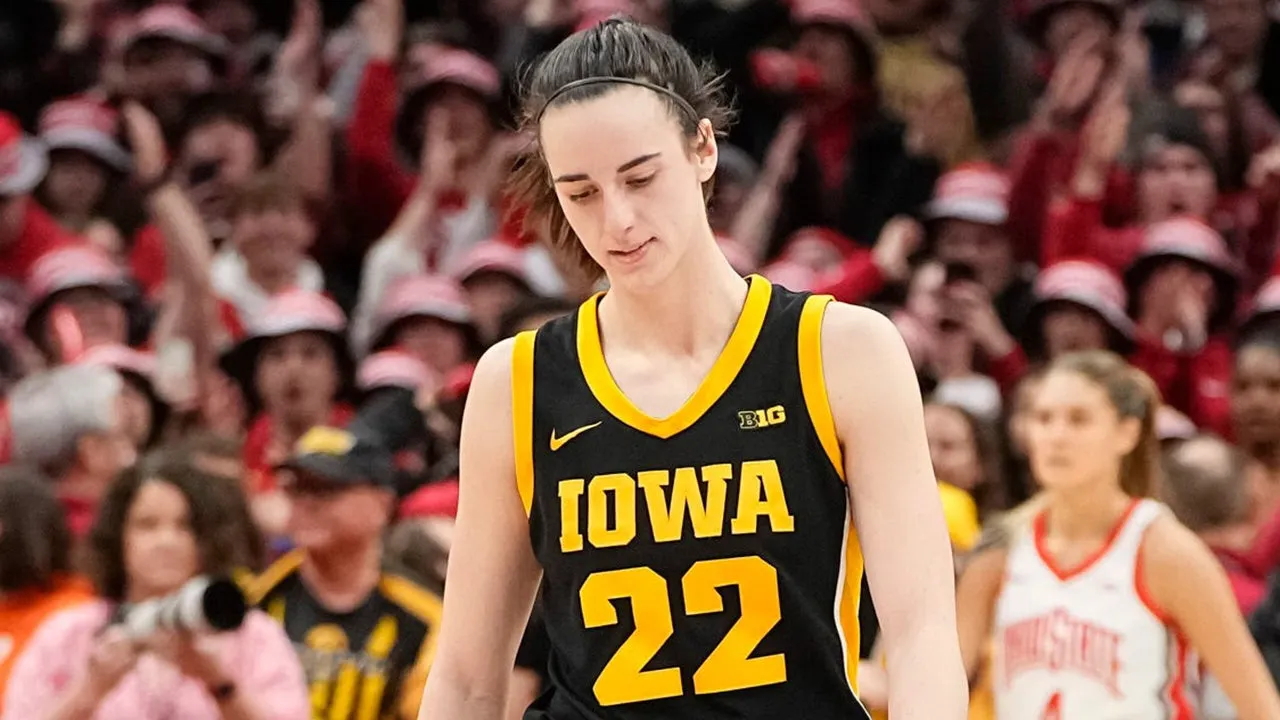
Sad News: Just Now”Caitlin Clark has just band for three years for insulting…
College basketball has always included pictures of students rushing out of the stands at the final buzzer to rejoice with players on the home team after a major victory. Usually, nobody is harmed.
However, since Iowa standout Caitlin Clark collided with an Ohio State supporter during the Buckeyes’ upset of the Hawkeyes in Columbus, court storming and the safety dangers that go along with it have been under more scrutiny.Since the Clark incident, there have been at least five additional cases, and ESPN analyst Jay Bilas called for the tradition to halt on Saturday. During the “College Gameday” program, Bilas made remarks that went viral, saying that spectators should never be let on the court.
“I’m confident it will last.”
College basketball history has seen pictures of students rushing out of the stands to celebrate with home team players after a significant victory. In most cases, nobody is harmed.
But in the week following Iowa standout Caitlin Clark’s collision with an Ohio State supporter during the Buckeyes’ upset of the Hawkeyes in Columbus, court storming and the safety dangers it poses have come under increased scrutiny.Since the Clark incident, at least five additional cases have occurred, and ESPN pundit Jay Bilas called for an end to the custom on Saturday. After saying that spectators shouldn’t ever be permitted on the court during the “College Gameday” program, Bilas’ remarks went viral.
Additionally, on Thursday at Oregon State, and on Saturday at Iowa State and Wyoming, spectators flooded the court.
In the event that storming happens before the visiting team and game officials have safely left the premises, schools could face penalties from their conferences.Bilas and other observers claim that those who engage should face consequences, whether they are legal or not, and refer to the punishments as window dressing.
Gil Fried, a business professor at the University of West Florida, has been an expert witness in court cases concerning injuries experienced at sports and entertainment venues for more than 30 years. He also offers training in crowd control.
He suggested that the best course of action would be for schools to establish a policy that makes it clear that spectators are not permitted on the court and that anyone found doing so risks having their tickets revoked or being barred from the arena.
Finding and apprehending infringers would be a challenge. In order to deter hooliganism, Fried proposed that arenas be outfitted with facial recognition equipment, which is frequently employed in soccer stadiums throughout Europe and Latin America.State and privacy laws in the US could make it difficult to use the technology, and no US colleges have expressed interest in it for that reason, according to Micah Willbrand, vice president of enterprise identity and chief product officer at NEC, which makes facial recognition technology for soccer.
The best course of action, according to him, would be for schools to adopt a clearly worded policy prohibiting supporters from entering the court; those who do so risk having their tickets revoked or being barred from the arena.
Finding and apprehending offenders would be the difficult part. Fried proposed using facial recognition technology in arenas, a measure that is frequently taken to deter hooliganism in soccer stadiums across Europe and Latin America.According to Micah Willbrand, chief product officer and vice president of enterprise identity at NEC, which makes facial recognition technology for soccer, state and privacy laws in the US could make using the technology difficult. No US colleges have expressed interest in using it for that reason.
Following Saturday’s 79-75 victory against No. 7 Kansas, there was the first court storming at Iowa State’s Hilton Coliseum in eight seasons.
At the final buzzer, security guards wearing orange vests onto the court to keep fans and players apart during the handshake line.
The Jayhawks then left the floor on the side of their bench, as do all visiting teams, to avoid having to pass through spectators.
Additionally, fences in front of the ISU student area slowed down the surge by funneling students into one route rather than creating a mass flow.Ben Johnson, the coach of Minnesota, stated that there is no benefit to supporters mingling with rival players.
Johnson stated, “It only takes one child to mouth something or say something that could start something.” “So, while being physically struck is one thing, I also think that getting struck also makes your emotions more intense.”
This year, the SEC increased the penalties for court and field storming to $100,000 for a first offense and $250,000 for a subsequent transgression.
In order to avoid having to pass through spectators on the court, the Jayhawks, like other visiting teams, then left on the side of their bench.
Furthermore, to slow down the rush, fences were erected in front of the ISU student area, funneling students in one way rather than creating a mass flow.Nothing positive comes from supporters mingling with rival players, according to Minnesota coach Ben Johnson.
According to Johnson, all it takes is for one child to mouth or say something that might ignite something. “So, while the physical aspect of being struck is one thing, I also suspect that my emotions are elevated.”
The SEC increased its penalties for court and field storming this year to $250,000 for a second infraction and $100,000 for a first.




